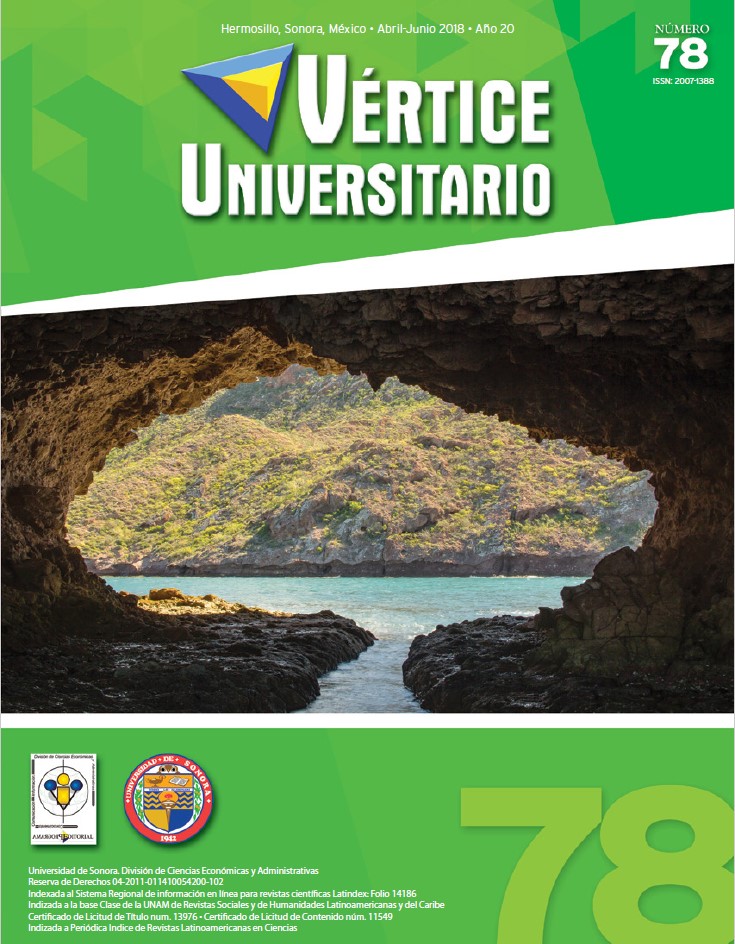Social Networks and Making Decisions: Evidence with Two Groups of Milk Producers in Hermosillo, Sonora
Keywords:
Social networks, making decisions, periurban milk producers.Abstract
The aim of the work is to characterize social networks and decision making of two groups of milk producers, located in the periphery of the urban area of the city of Hermosillo, Sonora, Mexico. Through an analysis of social networks and a decision-making matrix, it was found that i. The links in the network structure of the Los Bagotes producers was low, and its deci-sion making presented an asynchronous distribution; ii. The links in the network structure of La Yesca producers was medium, and the distribution of decision making was face to face. The evidence presented in this work shows that milk producing organizations are in a transition towards the consolidation of interdependent structures, which will reward the growth of the productive organization.
Downloads
References
Ávila S. (2009). Periurbanización y espacios rurales en la periferia de las ciudades. Estudios Agrarios. (41), pp. 93-123.
Barsky, A. (2005) El periurbano productivo, un espacio en constante transformación. Intro-ducción al estado del debate, con referencias al caso de Buenos Aires. Scripta Nova, IX (194), disponible en: http://www.ub.edu/geocrit/sn/sn-194- 36.htm [Accesado en 2013].
Banco Interamericano de Desarrollo. (2017). Financiamiento del Sector Agroalimentario y Desarrollo Rural.
Buckingham, S., Cannavacciuolo, L., De Liddo, A., Iandoli, L., y Quinto, I. (2011). Using social network analysis to support collective decision-making process. International Journal of Decision Support System Technology, 3 (2), pp. 15-31.
Castro, G., Lozano, A., Fernández, G., Ronca, F., y Rodríguez, D. (2005) Agrobiodiversidad y pobreza. Archivos de Zootecnia, 54.
Castro, G., y Lozano, A. (2009). Desafíos y oportunidades para la ganadería urbana y periur-bana en ciudades de América Latina y El Caribe. Cuadernos de Agricultura Urbana, 7, 44p.
Escalante, R., Catalán, H., y Basurto, S. (2013). Determinantes del crédito en el sector agro-pecuario mexicano: un análisis mediante un modelo Probit. Cuadernos de Desarrollo Rural, 10 (71), 101-124.
FAO, (1999). Agricultura urbana y periurbana. Recuperado de http://www.fao.org/ag/ agp/greenercities/pdf/compendium. pdf
Fernández Q., D. (2008). El análisis de redes sociales aplicado al estudio de la estructura de las industrias culturales. Congreso I+C: Investigar la Comunicación, Santiago de Compostela, 20 de enero a 1 de febrero de 2008.
Fletschner, D., y Kenney, L. (2011). Rural women ́s access to financial services: Credit, sav-ings and insurance. ESA Working Paper (11).
FND. (2017). Programa de Financiamiento para Pequeños Productores. Recuperado de https://www.gob.mx/ fnd/acciones-y-programas/programa- de-financiamiento-para-pequenos- productores-79302
Gaete, J. y Vásquez, J. (2008). Conocimiento y estructura en la investigación académica: una aproximación desde el análisis de redes sociales. REDES- Revista hispana para el análisis de redes sociales, 14 (5), pp. 1-33.
Hernández, R., Fernández, C., y Baptista, M. (2014). Metodología de la Investigación. Méxi-co: McGraw-Hill.
Hickson, D., y Pugh, D. (2006). Writers on Organizations. London: Penguin Books.
INEGI. (2013). Sistema Estatal y Municipal de Base de Datos. Recuperado de: http:// sc.inegi.org.mx/cobdem/contenido. jsp?rf=false&solicitud=
INEGI. (2018). PIB y Cuentas Nacionales. Recuperado de: http://www.inegi.org. mx/est/contenidos/proyectos/cn/
Kahneman, D., y Tversky, A. (1979). Prospect Theory: an analysis of decision under risk. Econometrica, 42 (2), 263-291.
Kahneman, D., y Frederick, S. (2001). Representativeness Revisited: Attribute Substitution in Intuitive Judgement. En T. Gilovich, D. Griffin & D. Kahneman (Eds.), Heuristics and Biases: The Psychology of Intuitive Judgment (pp. 49-81). Cambridge: Cambridge University Press.
Ley de Desarrollo Rural Sustentable. (2001). Capítulo XVII De la Seguridad y Soberanía Alimentaria, Artículo 179. https://www.juridicas.unam.mx/ legislacion/ordenamiento/ley-de- desarrollo-rural-sustentable#340366.
Lozares, C. (1996). La teoría de las redes sociales. Papers, No. 48, Universidad de Barcelona, Pp. 103-12.
Mitchell C. (1969). Social Networks in Urban Situations: Analyses of personal relationships in Central African towns. Manchester, University of Manchester.
Páez, C. (2013). Matrices y sistemas lineales.
Revista digital Matemática, Educación e Internet [En Línea] Primera Edición, 2003, disponible en: http://www. tecdigital.itcr.ac.cr/revistamatematica/ Libros/algebralineal/Matrices%20 y%20sistemas%20lineales.pdf [accesado en Marzo 2014].
Pérez, M. y Hartwich, F. (2008). Análisis de redes sociales aplicado al estudio de los procesos de innovación agrícola. REDES-Revista hispana para el análisis de redes sociales, 14 (1), pp. 1-31.
Putnam D., R. (2003). Entrevista. Muy Interesante [Electrónico], España, Revista Muy Intere-sante, 01 de Diciembre de 2003.
Requena, F. (1989). El concepto de red social.
Revista Española de Investigaciones Sociológicas, 48, pp. 137-152.
SAGARPA. (2018). CONVOCATORIA: Programa de Apoyos a Pequeños Productores 2018. Recuperado de https://webcache.googleusercontent. com/search?q=cache:HgF64B 1hNd8J:https://www.gob.mx/ sagarpa/acciones-y-programas/ programa-de-apoyos-a-pequenos- productores-2018+&cd=1&hl=es- 419&ct=clnk&gl=mx&client=safari
Salazar, V., Moreno M., y Arvizu, M. (2011). El sector rural del estado de Sonora: recursos naturales, demografía y estructuras agropecuaria y pesquera. En Borbón, C. (Ed.) Diagnóstico del sector agropecuario y pesquero del Estado de Sonora. México, pp: 17-96. Hermosillo, México: CIAD, SAGARHPA y SAGARPA.
Sanz M., L. (2003). Análisis de redes sociales: o cómo representar las estructuras sociales subyacentes. Apuntes de Ciencia y Tecnología. No 7, pp. 20-29.
Simon, H. (1982). Models of Bounded Rationality. Massachusetts: MIT Press.
Simon, H. (1997). Administrative Behavior. New York: SIMON & SCHUSTER.
SINIIGA. (2013). Número de unidades de producción pecuaria. Recuperado de https://www.siniiga.org.mx/pgn.html
Sunstein, C. (2006). Infotopia: How many minds produce knowledge? New York: Oxford University Press.
Tutte T., W. (2001). Graph Theory. Reino Unido: Cambridge University Press.
Tversky, A., y Kahneman, D. (1974). Judgment under Uncertainty: Heuristics and Biases. Science 185 (4157), pp.1124- 1131.
Vázquez, R., y Aguilar, I. (2010). Organizaciones lecheras en los Altos Sur de Jalisco: un análisis de las interacciones productivas. Región y Sociedad, XXII (48), pp. 113-144.
Zaraté, P., y Soubie, JL. (2004). An Overview of Supports for Collective Decision Making. Journal of Decision Systems 13 (2), pp. 211-221.
Published
How to Cite
Issue
Section
License
Copyright (c) 2018

This work is licensed under a Creative Commons Attribution-ShareAlike 4.0 International License.
The opinions expressed by the authors do not strictly reflect the position of the publisher of the publication. This work is under a CC Attribution-ShareAlike 4.0


















